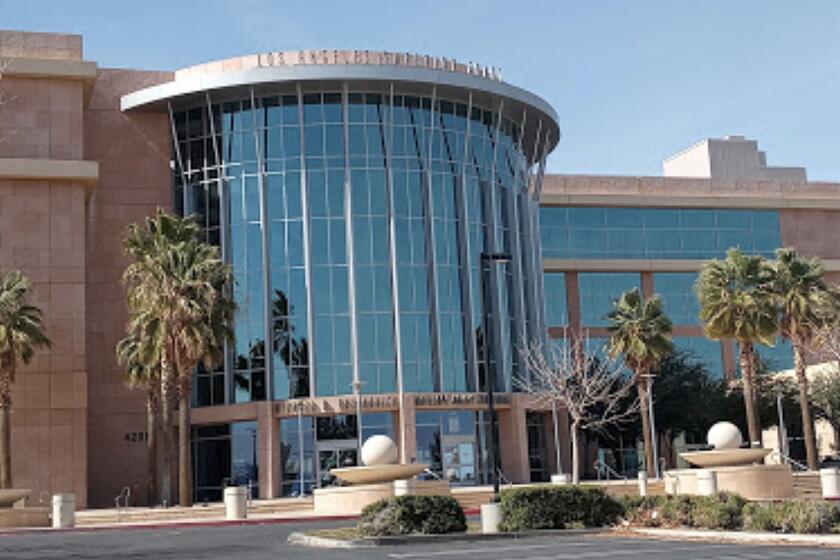Crime Falls in Fillmore Despite Jump in Residents : Law enforcement: A crackdown on gangs is credited for the drop. The community’s good fortune is in stark contrast to the rest of Ventura County.
- Share via
As a community’s population grows, crime usually goes up. But the small farm city of Fillmore is turning out to be an exception.
During the past two years, the number of crimes committed in Fillmore has dropped while its population--about 12,000--has grown by about 1,000 residents.
Fillmore’s good fortune is in stark contrast to the rest of Ventura County, where every other city showed a crime-rate increase in 1991 and overall crime jumped 13%.
And community officials and activists say there is a logical explanation: a crackdown on gangs that traditionally have generated big chunks of the town’s crime statistics.
“Violent crime is down mostly because of the gang crackdown,” said Sheriff’s Lt. Dick Purnell, who is, in effect, Fillmore’s police chief.
“We had a gang crackdown last year,” he said. “Dozens were arrested. We got the bulk of the key (members).”
As a result, he said, Fillmore’s serious crime rate dropped by nearly 5% in 1991.
And that downturn followed a 2% reduction in the city’s serious crime level the year before, according to the Ventura County sheriff’s annual crime report.
Violent crimes in Fillmore--homicides, rapes, robberies and assaults--fell to 52 last year contrasted with 81 the previous year, a decrease of nearly 36% in the violent-crime rate per 1,000 of population.
Purnell said aggravated assault, often a crime committed by gang members, dropped to 43 in 1991 contrasted with 66 in 1990, a decrease of nearly 35% per 1,000 of population.
The big drop in aggravated assaults is a direct result of the gang crackdown, Purnell said.
“Assaults are gang-driven,” he said.
According to Purnell, the story behind the statistics is one of a community growing more focused in its efforts to control gang activity.
“This community is unique in that people have been reacting as a community to the problems,” he said. “We were seeing an increase in gang activity and intimidation of the general populace.”
The rise of gang crime in Fillmore a few years ago came as a shock to many residents.
Hard by busy California 126, Fillmore, founded by the Southern Pacific Railroad in 1888 and incorporated in 1914, viewed itself as a quiet, safe place to live.
“Nothing’s perfect, but I think my town’s close to perfect,” said Fillmore City Councilman Roger Campbell, who owns a local auto-repair garage.
Many residents didn’t even bother to lock their doors when they left for work.
“In the ‘60s it was that way and even into the early ‘70s,” said Nancy Carrillo, a third generation Fillmore resident who owns Nancy’s, a popular eatery.
The rude awakening came a few years ago, she said, when “we got gang awareness.”
“My awakening to the gang problem was at sporting events,” said Fillmore Mayor Pro Tem Linda Brewster, a community activist. “All of a sudden, about five years ago, rock-throwing and fighting broke out” at local high school football games.
What was happening, Purnell said, was that Fillmore began feeling the impact of Ventura County’s growing pains.
To cope with the new reality, community leaders mobilized on a number of fronts.
One activist taking the lead was Father Norm Supancheck, 49, who for more than three years has administered Fillmore’s St. Francis of Assisi Church.
For 20 years he dealt with Latino gangs as a clergyman in East Los Angeles. But Supancheck finally decided he had to leave the big city.
“I was getting worn out,” he said.
Now, he relishes drawing from his experiences on the mean streets of Los Angeles.
“I know the kids,” he said of Fillmore’s 100 or so young Latinos, who, according to the sheriff’s intelligence, constitute the gangs that have been roaming the city’s streets.
Retreats are high on the list of the church’s efforts to redefine the priorities of gang members.
Ernie Morales, the church’s administrator, said up to 60 youngsters at a time are taken on retreats into the desert or mountains in an attempt to instill purpose into their lives.
Another major move was the formation of a communitywide youth task force designed to steer youthful energy into positive directions.
“It’s been a total community effort,” said Morales, 56, a former Fillmore mayor who served on the City Council for 16 years.
Lynn Edmonds, principal of Fillmore Junior High School, who has played a leadership role on the task force, said the group is beginning to show results.
“We look at students who tend to have a negative group involvement and get them involved in positive ways,” she said.
She cited task force supported community activities for young people such as a recent drama presentation featuring a mime at a local church, and a fishing derby.
Also, she said, the task force concept has served as “a clearinghouse of information” for other Fillmore groups with similar goals.
Meanwhile, Edmonds said a system of “peer helpers” was begun on the junior high campus at the start of the current school year. She said the effort is aimed at teaming students with positive attitudes with those perceived to have negative attitudes.
“We brainstormed why students are involved in negative groups,” she said. “We set up a peer-helper program.”
At yet another level, eight clergy people from five area churches met Wednesday at the Fillmore Bible Church in a further effort to break down youth barriers that breed distrust.
They talked about providing young people with social and religious experiences that they might not otherwise have, such as attending religious services in churches to which they did not belong.
“We need to take steps back and start from basics,” said Stephanie A. Acosta, a youth minister with the St. Francis of Assisi Church.
Along with the community mobilization came an increase in law enforcement activities also aimed at curbing the gang problem, Purnell said.
Following a spurt in gang activity in the first half of 1991, Purnell said there was a concerted push to put a lid on the violence in Fillmore’s streets.
In an effort to defuse gang tensions, Purnell last year organized a high-profile foot patrol in the city’s north end, a largely Latino area in a town whose population is about two-thirds Latino.
Two deputies, a full-time officer and a reserve deputy, walked neighborhood streets on weekends. Purnell said the program has helped keep gang activity down.
But as some other Fillmore residents tell the story, the Sheriff’s Department and community church groups were not the only leaders in Fillmore’s anti-crime battle. According to some Fillmore teen-agers who say they are local gang members, even the local gangs contributed to the effort.
In their view, one reason why violent crime has dropped is because Fillmore’s gang members took a vigilante-style approach, kicking rival gang youths from Santa Paula and Ventura out of town.
The students, male Latinos who attend Fillmore High School, spoke last week on the high school campus at the end of the academic day. Several wore black T-shirts and sneakers, a color popular with gangs, but also widely worn by students not affiliated with gangs.
“The cops haven’t done nothing,” said one of the students who wore a black T-shirt emblazoned with the Oakland Raiders football team logo. “They want (the credit) for themselves.”
The youths said they had shotguns and handguns, and last year confronted out-of-town gangs as they cruised Fillmore’s streets.
“It’s mostly territory stuff,” said one of the young men.
He said he and his buddies threw rocks at rivals’ cars and, at times, fired their weapons.
“We pulled over some guys from Santa Paula and shot three of them,” one said. “There’s no more trouble,” he said. “They haven’t come back.”
Purnell dismissed such talk as typical gang braggadocio.
“One of the things all gang members live for is to establish their turf and have other gang members in awe of them,” he said. “Their perception of the world is different than other people’s perception of the world.”
Meanwhile, there is still a gang problem in Fillmore.
On a patrol of the city last week, Sheriff’s Deputy Nancy Deloye confirmed the continuing gang activity as she drove through areas of the north end where walls were covered with gang graffiti.
Symbols and names--such as Juice, Shorty and Popeye--were spray-painted on cement walls. Two gangs--LBZ’s (Little Boys) and CWA (Chicanos With Attitudes)--appear to dominate Fillmore’s gang turf, she said.
The presence of gangs throughout the county as well as the continued gang activity in Fillmore is reason for the community to recognize that the anti-crime battle is not over, Purnell said.
“People who thought of Fillmore as it was at one time have to realize that what happens in other communities affects what happens in Fillmore,” he said. “Because Fillmore is a few miles away from other places, we tend to think of it as an isolated area. But, in reality, it only takes a few minutes to get here in a car.
“We not only have them home-grown, but we get them from other communities.”
More to Read
Sign up for Essential California
The most important California stories and recommendations in your inbox every morning.
You may occasionally receive promotional content from the Los Angeles Times.










